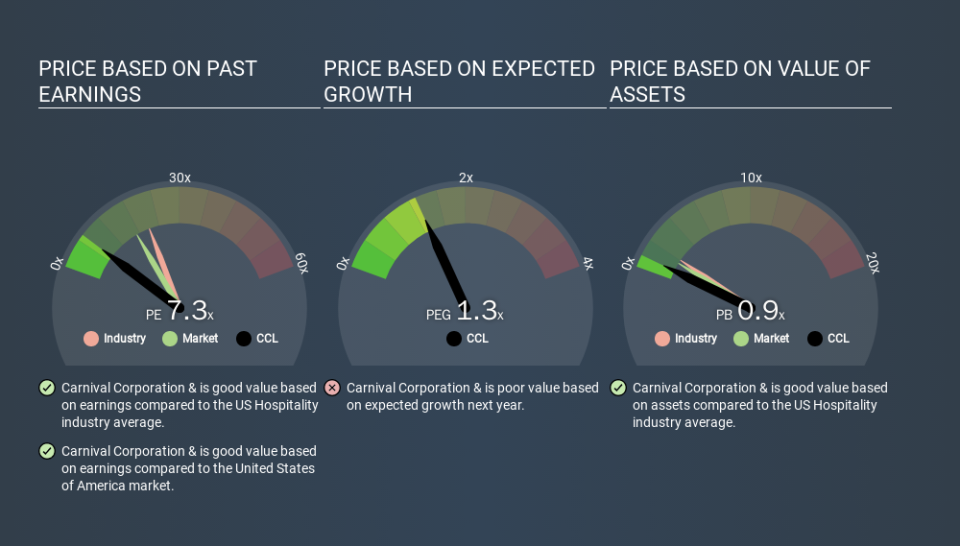What Is Carnival Corporation &'s (NYSE:CCL) P/E Ratio After Its Share Price Tanked?

Unfortunately for some shareholders, the Carnival Corporation & (NYSE:CCL) share price has dived 32% in the last thirty days. That drop has capped off a tough year for shareholders, with the share price down 45% in that time.
All else being equal, a share price drop should make a stock more attractive to potential investors. In the long term, share prices tend to follow earnings per share, but in the short term prices bounce around in response to short term factors (which are not always obvious). The implication here is that long term investors have an opportunity when expectations of a company are too low. Perhaps the simplest way to get a read on investors' expectations of a business is to look at its Price to Earnings Ratio (PE Ratio). Investors have optimistic expectations of companies with higher P/E ratios, compared to companies with lower P/E ratios.
See our latest analysis for Carnival Corporation &
How Does Carnival Corporation &'s P/E Ratio Compare To Its Peers?
Carnival Corporation &'s P/E of 7.35 indicates relatively low sentiment towards the stock. The image below shows that Carnival Corporation & has a lower P/E than the average (21.1) P/E for companies in the hospitality industry.
Its relatively low P/E ratio indicates that Carnival Corporation & shareholders think it will struggle to do as well as other companies in its industry classification. While current expectations are low, the stock could be undervalued if the situation is better than the market assumes. It is arguably worth checking if insiders are buying shares, because that might imply they believe the stock is undervalued.
How Growth Rates Impact P/E Ratios
Probably the most important factor in determining what P/E a company trades on is the earnings growth. If earnings are growing quickly, then the 'E' in the equation will increase faster than it would otherwise. Therefore, even if you pay a high multiple of earnings now, that multiple will become lower in the future. Then, a lower P/E should attract more buyers, pushing the share price up.
Carnival Corporation & saw earnings per share decrease by 2.5% last year. But over the longer term (5 years) earnings per share have increased by 23%.
Don't Forget: The P/E Does Not Account For Debt or Bank Deposits
Don't forget that the P/E ratio considers market capitalization. So it won't reflect the advantage of cash, or disadvantage of debt. In theory, a company can lower its future P/E ratio by using cash or debt to invest in growth.
Spending on growth might be good or bad a few years later, but the point is that the P/E ratio does not account for the option (or lack thereof).
Carnival Corporation &'s Balance Sheet
Net debt is 49% of Carnival Corporation &'s market cap. You'd want to be aware of this fact, but it doesn't bother us.
The Bottom Line On Carnival Corporation &'s P/E Ratio
Carnival Corporation & trades on a P/E ratio of 7.3, which is below the US market average of 16.9. Since it only carries a modest debt load, it's likely the low expectations implied by the P/E ratio arise from the lack of recent earnings growth. What can be absolutely certain is that the market has become more pessimistic about Carnival Corporation & over the last month, with the P/E ratio falling from 10.7 back then to 7.3 today. For those who prefer to invest with the flow of momentum, that might be a bad sign, but for deep value investors this stock might justify some research.
When the market is wrong about a stock, it gives savvy investors an opportunity. If the reality for a company is not as bad as the P/E ratio indicates, then the share price should increase as the market realizes this. So this free report on the analyst consensus forecasts could help you make a master move on this stock.
But note: Carnival Corporation & may not be the best stock to buy. So take a peek at this free list of interesting companies with strong recent earnings growth (and a P/E ratio below 20).
If you spot an error that warrants correction, please contact the editor at editorial-team@simplywallst.com. This article by Simply Wall St is general in nature. It does not constitute a recommendation to buy or sell any stock, and does not take account of your objectives, or your financial situation. Simply Wall St has no position in the stocks mentioned.
We aim to bring you long-term focused research analysis driven by fundamental data. Note that our analysis may not factor in the latest price-sensitive company announcements or qualitative material. Thank you for reading.

